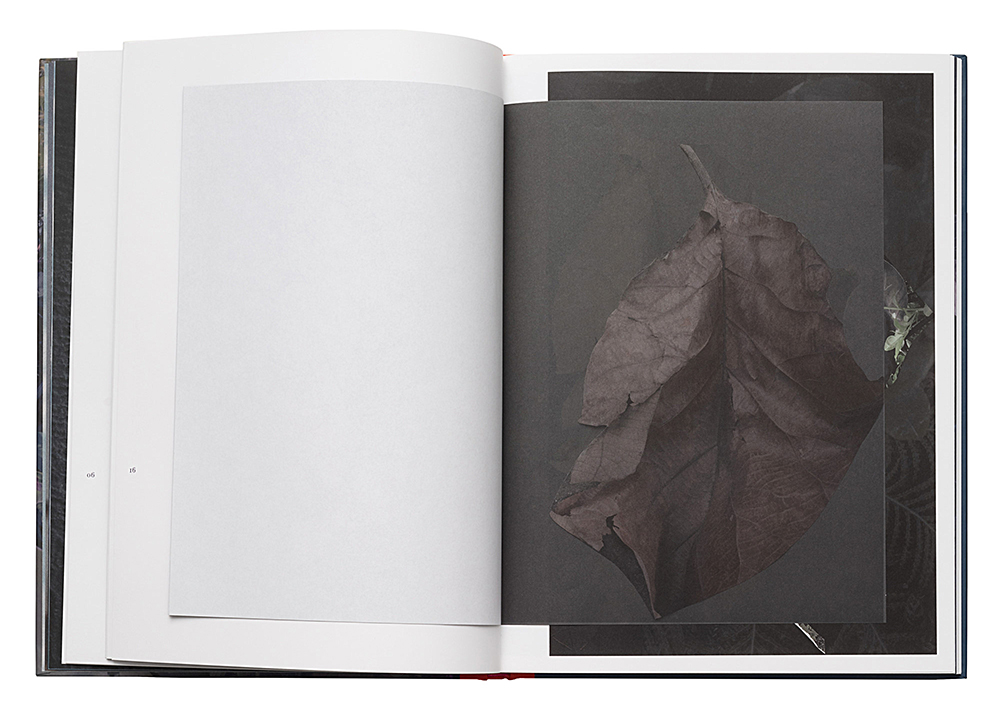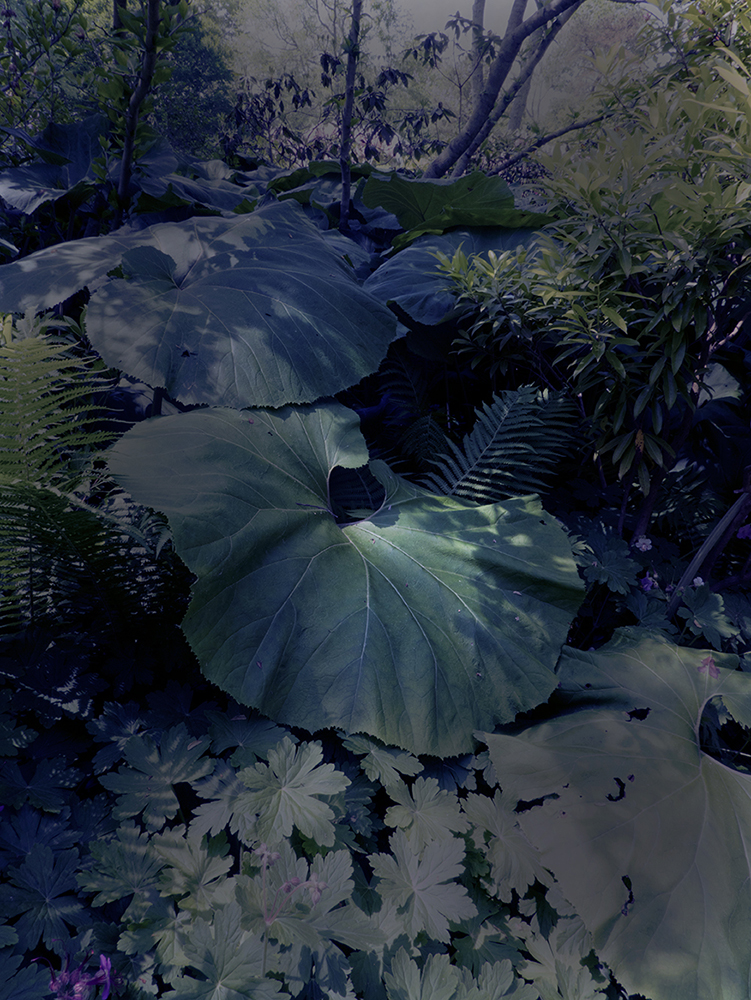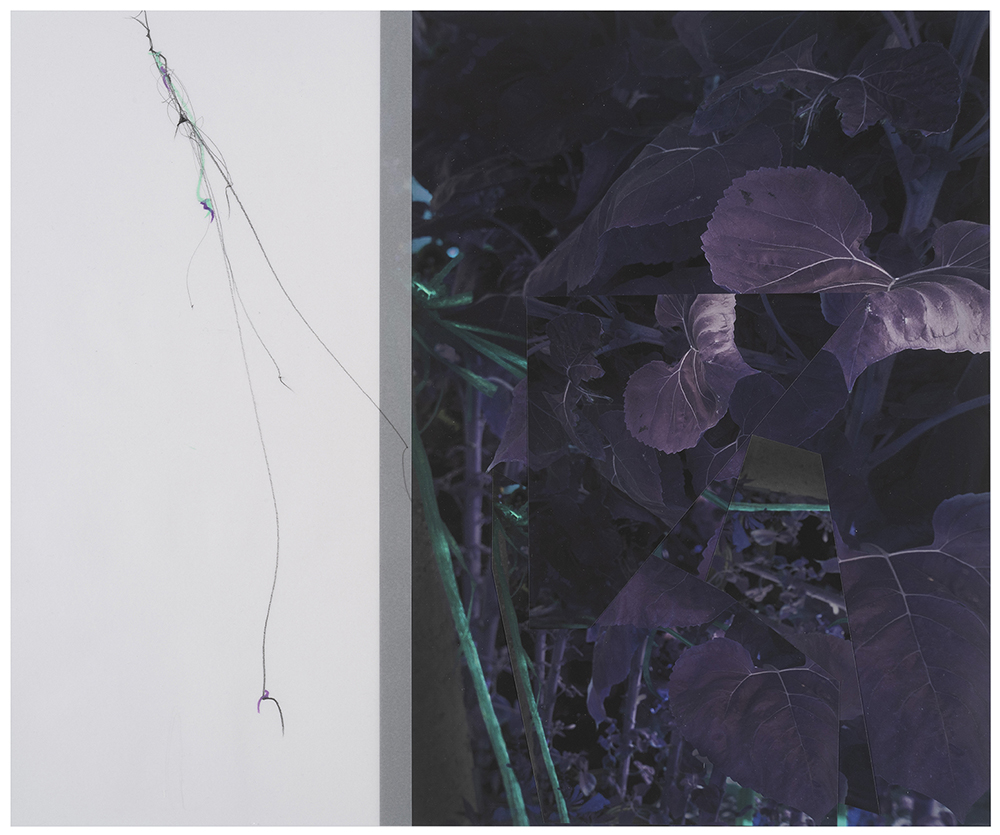Sandi Haber Fifield: The Certainty of Nothing
Are we ever prepared to comprehend the potential ramifications and receptions of what we make and leave behind? Global warming, rampant wildfires and deforestation, and widespread greed suggest not. I don’t share the culture or the religion underpinning the myths of Angkor Thom, but I share without question, their sense of the apocalyptic, the enormity of the cosmos. – Sandi Haber Fifield
With it’s brilliant orange spine and delicious color soaked photograph gracing the front cover of Sandi Haber Fifield’s new book, The Certainty of Nothing, the monograph is a spectacular celebration of seeing and transformation. Haber Fifield states, “… for me, photography is not just a method of recording the world, but a tool for examining and revealing its mysteries.” I would add to this sentiment that she also creates a personal sort of magic in her photo-based collages that keeps us in a liminal state of beauty and not quite knowing. The book itself is richly layered – the construction mimics her original photo-based pieces with laser cutting and selective silkscreen, which in a way, references the layers of history and growth of her subject matter. The work itself is revelatory in it’s alchemistic artistry, “I continue to use elements both natural and man-made; the formal elements of light and line and hand-wrought interventions – tearing, folding, puncturing, layering and drawing. My palette goes to extremes – deep dark and unknown to bleached pastel and ephemeral.”
The work and book is inspired by the ruins of Angkor, ancient sites built in the 12th century and once part of the Khmer Empire. Much has come and gone in this remarkable location and Haber Fifield captures its mystery and fragility. She expands upon the idea of the artist as an architect of nature with her recognizable drawing and collage techniques. In in her essay Haber Fifield states, “These are rocks that speak to the origin of all rocks, stone that somehow explain ‘stone.’ They are proof of how civilizations came into being. Then, as now, there was certainty in nothing. But still, they persisted.”.
The Certainty of Nothing is interwoven with words from “Perseverance,” a poem by award-winning writer Susan Minot. Additionally, the book includes an essay by the artist. The Certainty of Nothing and As Birdsongs Emerge will be on view at Yancey Richardson starting April 17th, 2021.
The Certainty of Nothing, 2019-2020
Unique Archival Collaged Pigment Prints; Graphite; Vellum
Sizes Range From 17”x 14” to 39” x 36”
We cannot fully understand the concept of the monumental until we witness the goals of centuries-old civilizations and the ways in which time and nature transformed them. I experienced both on my visit to the ruins of the Cambodian cities of Angkor Thom and Angkor Wat, which I photographed extensively, and which form the essence of this series, The Certainty of Nothing.
For centuries these ancient cities were reclaimed by the jungle before being returned to light. Hindu legend has it that the Gods and Demons worked together for a millennium, using a serpent as a rope, to churn the Ocean of Milk and release the nectar of life—emitting a terrible toxin in the process. The monumental figures – Gods and Demons – which flank the entrance to Angkor Thom and which were carved almost a thousand years ago, speak to that narrative. As the story goes on to teach us, when a great power, the “elixir,” is unleashed from the world, unexpected consequences can come in its wake.
Are we ever prepared to comprehend the potential ramifications and receptions of what we make and leave behind? Global warming, rampant wildfires and deforestation, and widespread greed suggest not. I don’t share the culture or the religion underpinning the myths of Angkor Thom, but I share without question, their sense of the apocalyptic, the enormity of the cosmos. It is back in my studio that I begin to make sense of it all, because for me, photography is not just a method of recording the world, but a tool for examining and revealing its mysteries.
I have always sought to tease out from photographs what the lens cannot show. This series is no exception. I continue to use elements both natural and man-made; the formal elements of light and line and hand-wrought interventions – tearing, folding, puncturing, layering and drawing. My palette goes to extremes – deep dark and unknown to bleached pastel and ephemeral. In the past, the man-made architecture I incorporated in my work spanned only recent decades; here, the structures go back almost a millennium. The stories, hopes, and dreams embedded in them, however, go back even longer. These are rocks that speak to the origins of all rocks, stones that somehow explain “stone.” They are proof of how civilizations came into being. Then, as now, there was certainty in nothing. But still, they persisted.
And here I am, visiting them after the centuries have pitted and bleached and toned and eroded their surfaces. In The Certainty of Nothing, rather than simply recording the intersections of man and nature as I usually do, I incorporate my contemporary response to these timeless monuments – I make my mark on their mark, adding another layer of time to the image. I want to “vent” or otherwise open a small gaze, portal, or alternate reading of these hard-to-descry ancient marks; layering and conflating them creates a new phenomenal and perceptual “play.”
A group of eighteen images in the series reference the same ancient stone wall but differ in tone and linear elements. The number nine is revered in Hindu culture as the end of the decimal system and numerically, the multiplication of nine with other digits is self-referential. To gently augment the stone wall’s lines (and in the process engage the eye) I use a sharp sculptor’s tool to follow the shapes etched ages ago by a once known stone artist. Punctuating the surface of the image with tiny pricks, I create a line of white dots which aerate the surface and allow light to infiltrate. In doing so, I invite the viewer to look beyond the original surfaces and bring attention to the ancients’ marks alongside my own. Today one might think of my lines as scarification, or tattoos, or perhaps of a traveler marking her itinerary through the ancient site. There is a slight wobble to the original marks as there is to mine, uniting us as human artisans from different times, cultures and systems of belief.
I used to see a vast world in corner lots and cracked surfaces, buildings and walls in my familiar corner of the universe. Now, having traveled around the globe, I feel the planet getting smaller.
Time has passed. Much has changed. Yet we don’t know what our future holds any more than the ancients did. I worry about the time in which I am living. I hope to communicate some small message, leaving a mark that will allow light to penetrate.
Sandi Haber Fifield was born in Youngstown, Ohio and currently resides on Shelter Island, NY. She received her MFA in photography from Rochester Institute of Technology, and her work has been widely exhibited in galleries and museums throughout the United States including The Art Institute of Chicago; The de Cordova Museum; The Museum of Modern Art; The Philadelphia Museum; The National Museum of Women in the Arts; and The St. Louis Museum. The artist’s photographs are represented by Yancey Richardson, New York City and Robert Klein Gallery, Boston.
Since the 1980s, Haber Fifield’s work has explored the visual, psychological and formal possibilities in creating composite pictures, whether it is the layering of images in the analog process of multiple exposure in-camera or by challenging logic and blowing apart the traditional expectation of ordered images on a wall. Richard Klein, Director of the Aldrich Art Museum says, “Sandi Haber Fifield’s haunting and quietly beautiful work with multiple images is extremely pertinent to this moment in photography’s continuing evolution. Her approach forces the viewer to slow down and consider the relationship between images. Never bombastic or sensational, the artist’s work is both a corollary to our current visual environment as well as its antidote.”
With her series LINEATIONS, 2014-2018, Haber Fifield expanded her photographic practice: a series that includes hand-drawn marks, layers of vellum, and other material interventions that interrupt the flat nature of the medium, driving the work into the realm of photo-based construction.
Her two recent bodies of work were completed in 2021. In As Birdsongs Emerge the artist considers what occurs in the mind, memory, and eye when the seeing plane is abruptly spliced or when a recognizable signifier as plain as a rose bush appears to be collapsing in on itself. Haber Fifield addresses these issues by further extending the photographic space, shifting between the background and foreground, geometric spaces and the natural world. Image fragments are layered, integrated and frequently thrown into conflict, yet no single material or conceptual element outweighs the other. As Birdsongs Emerge seeks not to resolve but question the strata of seeing.
In 2019 the artist visited the ancient ruins of Angkor which were built in the 12th century and which inspired her 2021 monograph and series of images, The Certainty of Nothing. Much has come and gone in this remarkable location and Haber Fifield captures its mystery and fragility. She expands upon the idea of the artist as an architect of nature with her recognizable drawing and collage techniques that capture the centuries-old stone monuments and primeval foliage.
Posts on Lenscratch may not be reproduced without the permission of the Lenscratch staff and the photographer.
Recommended
-
Ricardo Miguel Hernández: When the memory turns to dust and Beyond PainNovember 28th, 2025
-
Pamela Landau Connolly: Columbus DriveNovember 26th, 2025
-
KELIY ANDERSON-STALEY: Wilderness No longer at the Edge of ThingsNovember 19th, 2025
-
Jackie Mulder: Thought TrailsNovember 18th, 2025
-
Accidental Evidence: Mike Mandel and Chantal ZakariOctober 22nd, 2025































































